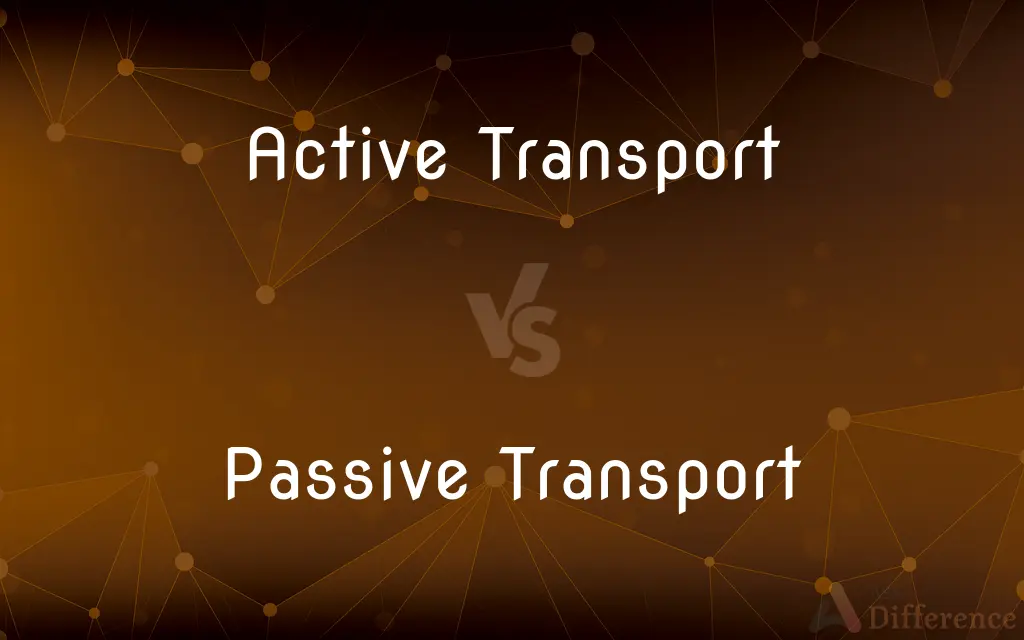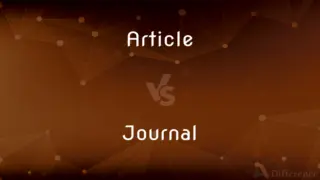Active Transport vs. Passive Transport — What's the Difference?
Edited by Tayyaba Rehman — By Fiza Rafique — Published on December 12, 2023
Active Transport requires energy to move substances against concentration gradients; Passive Transport moves substances naturally without energy, following gradients.

Difference Between Active Transport and Passive Transport
Table of Contents
ADVERTISEMENT
Key Differences
Active Transport is a cellular process where substances are moved against their concentration gradients, meaning from an area of lower concentration to an area of higher concentration. This movement is contrary to natural diffusion and thus requires energy, typically in the form of ATP. On the other hand, Passive Transport is a natural process where substances move along their concentration gradients, from an area of higher concentration to one of lower concentration, without the need for any energy input.
When considering Active Transport, it's essential to recognize the significance of cellular pumps, like the sodium-potassium pump, which actively transport ions in and out of cells. This process ensures that cells maintain specific concentrations of essential ions. Passive Transport, in contrast, encompasses methods like osmosis (for water) and simple diffusion, where molecules freely move across permeable membranes without cellular energy.
Moreover, Active Transport can be thought of as the cell's investment to maintain its internal environment, especially when surrounding conditions might work against equilibrium. It is a proactive approach. Whereas Passive Transport is more of a natural balance or equilibrium-seeking process that relies on inherent molecular motion.
From a structural perspective, Active Transport often relies on specialized proteins, or pumps, within the cell membrane to facilitate movement. These proteins bind with molecules and actively "push" them against their gradient. In contrast, Passive Transport may utilize channels or merely the permeable nature of the cell membrane, allowing molecules to drift through based on their inherent kinetic energy.
From an energy standpoint, Active Transport is like climbing uphill, demanding added effort and energy. In comparison, Passive Transport is akin to rolling downhill, where things naturally move without any added force.
ADVERTISEMENT
Comparison Chart
Energy Requirement
Requires energy (often ATP)
Does not require energy
Direction of Movement
Against concentration gradients
With concentration gradients
Cellular Structures Involved
Uses specialized proteins/pumps
Uses channels or membrane's permeability
Nature of Process
Proactive approach to maintain equilibrium
Natural, equilibrium-seeking process
Examples
Sodium-potassium pump
Osmosis, simple diffusion
Compare with Definitions
Active Transport
The ATP-reliant transportation of molecules across cell membranes.
Active Transport ensures specific ions remain at optimal levels within cells.
Passive Transport
Movement of substances along concentration gradients without energy use.
Oxygen entering cells by diffusion is a form of Passive Transport.
Active Transport
A process requiring energy to move substances against their gradients.
The sodium-potassium pump operates through Active Transport to maintain cellular ion balance.
Passive Transport
Natural transportation process not requiring cellular energy.
Water molecules move by osmosis, a type of Passive Transport.
Active Transport
An energy-demanding mechanism to transport substances uphill in concentration.
To remove toxins, some cells employ Active Transport mechanisms.
Passive Transport
Spontaneous movement of molecules through permeable membranes.
Carbon dioxide exits cells through Passive Transport.
Active Transport
Cellular movement of molecules against concentration differences using energy.
Cells use Active Transport to accumulate nutrients at higher concentrations than their surroundings.
Passive Transport
Cellular process relying on inherent molecular motion for transport.
The balance of water in cells is maintained through Passive Transport mechanisms.
Active Transport
Facilitated movement against natural diffusion using cellular energy.
Nutrient uptake in roots often involves Active Transport.
Passive Transport
Equilibrium-seeking transport without the need for ATP.
The scent of a flower spreading in air occurs through Passive Transport.
Common Curiosities
Is osmosis an Active or Passive Transport process?
Osmosis is a type of Passive Transport where water moves across membranes.
Can Passive Transport occur without any proteins?
Yes, simple diffusion is a form of Passive Transport that doesn't always require proteins.
Does Passive Transport always occur from high to low concentration?
Yes, Passive Transport naturally moves substances from areas of high to low concentration.
What's the primary distinction between Active Transport and Passive Transport?
Active Transport uses energy to move substances against gradients, while Passive Transport doesn't use energy and follows gradients.
How does temperature impact Passive Transport?
Higher temperatures can increase the rate of Passive Transport due to increased molecular motion.
Why does Active Transport require energy?
Active Transport moves substances against their natural concentration gradients, necessitating energy input, typically ATP.
What's an example of an Active Transport mechanism in cells?
The sodium-potassium pump in cells is an example of Active Transport.
Can Active Transport ever move substances with the gradient?
Typically, Active Transport is characterized by moving substances against the gradient, not with it.
What drives the energy requirement in Active Transport?
In Active Transport, ATP (adenosine triphosphate) often provides the necessary energy.
Why do cells undergo Active Transport?
Cells use Active Transport to maintain internal concentrations of molecules essential for their functions.
Are there different types of Passive Transport?
Yes, Passive Transport includes simple diffusion, facilitated diffusion, and osmosis.
Do both types of transport use the cell membrane?
Yes, both Active Transport and Passive Transport involve the movement of substances across the cell membrane.
Can a cell control Passive Transport?
While Passive Transport is spontaneous, cells can influence it by having selective channels or changing membrane permeability.
Is facilitated diffusion a type of Active Transport?
No, facilitated diffusion is a form of Passive Transport using specific transport proteins but doesn't require energy.
Which transport method is faster, Active or Passive?
The speed can vary based on conditions, but Passive Transport can be quicker when the gradient is steep.
Share Your Discovery

Previous Comparison
Black Crickets vs. Brown Crickets
Next Comparison
Normal Phase Chromatography vs. Reverse Phase ChromatographyAuthor Spotlight
Written by
Fiza RafiqueFiza Rafique is a skilled content writer at AskDifference.com, where she meticulously refines and enhances written pieces. Drawing from her vast editorial expertise, Fiza ensures clarity, accuracy, and precision in every article. Passionate about language, she continually seeks to elevate the quality of content for readers worldwide.
Edited by
Tayyaba RehmanTayyaba Rehman is a distinguished writer, currently serving as a primary contributor to askdifference.com. As a researcher in semantics and etymology, Tayyaba's passion for the complexity of languages and their distinctions has found a perfect home on the platform. Tayyaba delves into the intricacies of language, distinguishing between commonly confused words and phrases, thereby providing clarity for readers worldwide.















































